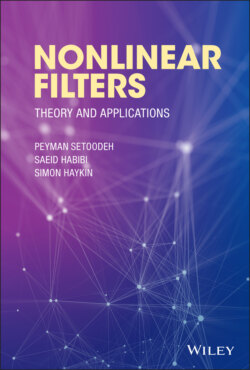Читать книгу Nonlinear Filters - Simon Haykin - Страница 26
2.6.1 Continuous‐Time Nonlinear Systems
ОглавлениеThe state‐space model of a continuous‐time nonlinear system is represented by the following system of nonlinear equations:
(2.61)
(2.62)
where is the system function, and is the measurement function. It is common practice to deploy a control law that uses state feedback. In such cases, the control input is itself a function of the state vector . Before proceeding, we need to recall the concept of Lie derivative from differential geometry [22, 23]. Assuming that and are smooth vector functions (they have derivatives of all orders or they can be differentiated infinitely many times), the Lie derivative of (the th element of ) with respect to is a scalar function defined as:
(2.63)
where denotes the gradient with respect to . For simplicity, arguments of the functions have not been shown. Repeated Lie derivatives are defined as:
(2.64)
with
(2.65)
Relevance of Lie derivatives to observability of nonlinear systems becomes clear, when we consider successive derivatives of the output vector as follows:
(2.66)
The aforementioned differential equations can be rewritten in the following compact form:
(2.67)
where
(2.68)
and
(2.69)
The system of nonlinear differential equations in (2.67) can be linearized about an initial state to develop a test for local observability of the nonlinear system (2.61) and (2.62) at this specific initial state, where the linearized test would be similar to the observability test for linear systems. Writing the Taylor series expansion of the function about and ignoring higher‐order terms, we will have:
(2.70)
Using Cartan's formula:
(2.71)
we obtain:
(2.72)
Now, we can proceed with deriving the local observability test for nonlinear systems based on the aforementioned linearized system of equations. The nonlinear system in (2.61) and (2.62) is observable at , if there exists a neighborhood of and an ‐tuple of integers called observability indices such that [9, 24]:
1 for .
2 The row vectors of are linearly independent.
From the row vectors , an observability matrix can be constructed for the continuous‐time nonlinear system in (2.61) and (2.62) as follows:
(2.73)
If is full‐rank, then the nonlinear system in (2.61) and (2.62) is locally weakly observable. It is worth noting that the observability matrix for continuous‐time linear systems (2.7) is a special case of the observability matrix for continuous‐time nonlinear systems (2.73). In other words, if and are linear functions, then (2.73) will be reduced to (2.7) [9, 24].
The nonlinear system in (2.61) and (2.62) can be linearized about . Using Taylor series expansion and ignoring higher‐order terms, we will have the following linearized system:
(2.74)
(2.75)
Then, the observability test for linear systems can be applied to the following linearized system matrices:
(2.76)
(2.77)
In this way, the nonlinear observability matrix in (2.73) can be approximated by the observability matrix, which is constructed using and in (2.76) and (2.77). Although this approach may seem simpler, observability of the linearized system may not imply the observability of the original nonlinear system [9].
